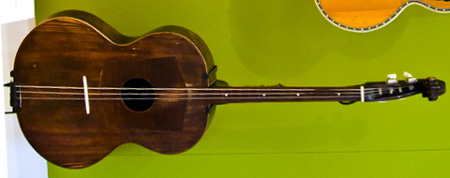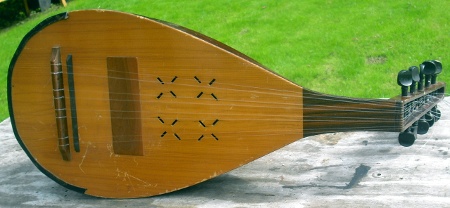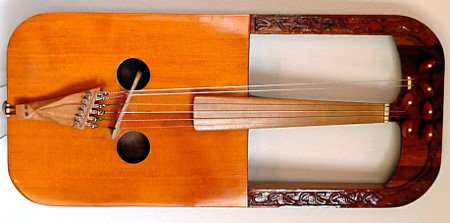The Stringed Instrument Database
C

Cak
Alternative names: Keroncong Cak
Origin: Indonesia
Tuning: D5 D5, G4, B4
Strings/Courses: 4/3
Further notes: Played with the Cuk (see below) in Keroncong music. Steel strings.
Scale Length: 355-375mm

Cavaquinho
Alternative names: Cavaco, Manchete, Machimbo
Origin: Portugal
Tuning: D3, G3, B3, D4 or A3, A3, C#4, E4.
Strings/Courses: 4/4
Further notes: Originally from Portugal, but now variants are played throughout the world. It was carried by Portugese sailors on ships due to it's convenient size. In Brazil, they play a larger-bodied Cavaquinho. The Madeiran Braghinha and Hawaiian Ukulele are both descendents of this instrument. Sometimes the Portugese Cavaquinho has tuning machines similar to the Guitarra Portuguesa, rather than the type shown here. Steel strings, or sometimes nylon (traditionally gut). A cavaquinho player is called a cavaquista.
Scale Length: Usually about 330mm

Cavaquinho, Brazilian
Alternative names: Cavaco, Manchete, Machimbo
Origin: Brazil, developing from the Portuguese version above.
Tuning: D3, G3, B3, D4
Strings/Courses: 4/4
Further notes: The Brazilian version always has steel strings.
Scale Length: Usually about 330mm

Cekuntrung
Alternative names:
Origin: Indonesia
Tuning:
Strings/Courses: 4/4 or 2/2
Further notes:
Scale Length:

Cello
Alternative names: Originally short for Violoncello.
Origin: Italy, 16th century.
Tuning: C2, G2, D3, A3
Strings/Courses: 4/4
Further notes: Steel strings.
Scale Length: 695-700mm
Cello Banjo
- See Banjo, Cello.

Celovic
Alternative names: Celo, Csello, Cselo.
Origin:Croatia, Serbia, Slovenia
Tuning: E2, A2, D3, G3
Strings/Courses: 4/4
Further notes: Steel strings.
Scale Length: 600-875mm

Cetera
Alternative names: Citare
Origin: Corsica, France, 17th century. Nearly died out but was reveived in the 1970's.
Tuning: Often tuned to the taste of the performer, but usually only the highest 4 courses are fretted, and the rest are only played open, and are tuned chromatically like an archlute.
Strings/Courses: 16/8 or 14/7
Further notes: Steel strings.
Scale Length: 450-600mm

Chanzy
Alternative names: Chanzi, Tyanzi
Origin: Tuva, Eastern Russia
Tuning: F2, C3, F3 or D2 A2 D3 or C2 G2 C3
Strings/Courses: 3/3
Further notes: Nylon strings.
Scale Length: 660mm

Chapey
Alternative names: Grajappi, Grajabpi, Chapei, Kratchappi, Krachap-pi, Chapey Dong Veng, Chapi
Origin: Thailand and Cambodia
Tuning: F3 F3, B3 B3
Strings/Courses: 2/2, 3/2 or 4/2
Further notes: The two courses can be single, doubled, or one of each. Nylon or silk strings.
Scale Length: 800-900mm

Charango
Alternative names: Quirquincho, Mulita, Tatu, Kirki.
Origin: Andean mountains, South America. 17th or 18th century.
Tuning: G4 G4, C5 C5, E5 E4, A4 A4, E5 E5
Strings/Courses: 10/5
Further notes: Traditionally charangos were made out of armadillo shells. Nowadays they are usually carved from solid wood, but are sometimes also made with flat backs and bent sides. Nylon strings.
Scale Length: 350-370mm.

Charango, Hatun
Alternative names: Grand Charango
Origin: Peru. A recent invention.
Tuning: A3, D4, G4, C5, E5 E4, A4, E5
Strings/Courses: 8/7
Further notes: Nylon strings.
Scale Length: 370-380. Sometimes the two lowest courses have a longer scale length and a seperate fretboard.

Charango, Ranka
Alternative names: Patasi Charango, Ranqha Charango
Origin: Cochabamba, central Bolivia.
Tuning: G4 G4, C5 C5, E5 E4, A4 A4, E5 E5 E6 or D4 D4, A4 A4, G5 G4, C5 C5, G5 G5 G6.
Strings/Courses: 11/5
Further notes: Nylon or steel strings.
Scale Length: 350-380mm.

Charango Vallegrandino
Alternative names:
Origin: Vallegrande, South-western Bolivia.
Tuning: G4, C5 C5, E5 E5, A4 or A4, D5 D5, F#5 F#5, B4 or A4, F5 F5, G5 G5, B5
Strings/Courses: 6/4
Further notes: Now quite rare.
Scale Length: ABout 330mm

Chikara
Alternative names:
Origin: Bengal, India.
Tuning: C, F, G
Strings/Courses: 3/3 with sympathetic strings.
Further notes:
Scale Length:

Chinlili
Alternative names: Chinlilo
Origin: Ayacucho, Peru.
Tuning: G, B, D, G, B, E
Strings/Courses: 8/6 or 7/6
Further notes: The doubled courses are tuned in octaves. The frets are laid out diatonically like a Dulcimer. Metal strings.
Scale Length:

Chitarra Battente
Alternative names:
Origin: Southern Italy, 17th century.
Tuning: A3 A3, D4 D4, G3 G3, B3 B3, E4 E4
Strings/Courses: 10/5
Further notes: Italian for 'beating Guitar', due to the fact it is largely for strumming. Steel strings.
Scale Length: Varies. There are at least 3 different sizes. 640mm is a common scale length.

Chonguri
Alternative names: Choghur
Origin: Georgia, 16th century.
Tuning: D3, F3, D4, A3 or D3, G3, B4, D4
Strings/Courses: 4/4
Further notes: Nylon strings.
Scale Length: 630mm

Chuniri
Alternative names: Chianuri
Origin: Georgia.
Tuning:
Strings/Courses: 3/3
Further notes:
Scale Length:

Ciftelia
Alternative names: Cifteli, Dyzen, Karadyzen, Ciftetelli, Qifteli.
Origin: Albania
Tuning: B3, E3
Strings/Courses: 2/2
Further notes: Steel strings.
Scale Length: About 630mm, but varies widely.

Cinco Y Medio
Alternative names:
Origin: Venezuela
Tuning: E3, A3, D3, F#4, B4, E4
Strings/Courses: 6/6
Further notes: Nylon strings.
Scale Length: 480mm

Cittern
Alternative names:
Origin: Europe, 16th century.
Tuning: C2 C2, G2 G2, D3 D3, A3 A3, E4 E4 is the standard tuning, but often modal tunings are used, especially in Celtic and Irish music. Sometimes the lower courses are tuned in octaves.
Strings/Courses: 10/5
Further notes: Not to be confused with the Renaissance cittern. Steel strings.
Scale Length: 580-640mm

Cobza
Alternative names: Kobsa, Koboz (in Hungary), Kobza
Origin: Romania and Hungary.
Tuning: D D, A A, D D, G G.
Strings/Courses: Usually 8/4, but sometimes 10/4 or 10/5.
Further notes: Usually steel strings, but sometimes nylon. Nylon strings are more common in Hungary than Romania.
Scale Length: 480mm

Concheros
Alternative names:
Origin: Mexico.
Tuning:
Strings/Courses: 8/4 (called mandolina concheros), 10/5 (called vihuela concheros) or 12/6 (caled guitarra concheros).
Further notes: Steel strings.
Scale Length: 500-600mm

Crwth
Alternative names:
Origin: Europe, 11th century. Took it's present form in Wales, where it is now most popular.
Tuning: G2, C3, C2, D2, D3
Strings/Courses: 5/5 and 6/5 are common. Huge variation.
Further notes: Nylon, gut or steel strings.
Scale Length: No standard, because the Crwth is not made on a wide scale, and is usually handmade by luthiers.

Cuatro Antiguo
Alternative names:
Origin: Puerto Rico, 17th century.
Tuning: A3, E4, A4, D5
Strings/Courses: 4/4 or 8/4
Further notes: Means 'old cuatro'. Nylon or steel strings. Traditionally gut or strips of rawhide. Not played much anymore, although recently has been revived.
Scale Length: 450-500mm

Cuatro Cubano
Alternative names: Cuban Cuatro, Tres-Cuatro, Cuatres
Origin: Eastern Cuba.
Tuning: G4 G3, C4 C4, E4 E4, A4 A4 or G4 G3, C4 C4, E4 E4, G4 G4 or A4 A3, D4 D4, F#4 F#4, B4 B4
Strings/Courses: 8/4
Further notes: Steel strings. Evolved from the Cuban Tres/Tres Cubano. An extra course was added. Not played very often.
Scale Length: 480-650mm

Cuatro Puertorriqueno
Alternative names: Puerto Rican Cuatro, Cuatro Aviolinado, Cuatro Moderno (to distinguish from the Cuatro Antiguo above).
Origin: Puerto Rico, 19th century.
Tuning: B3 B2, E4 E3, A3 A3, D4 D4, G4 G4
Strings/Courses: 10/5
Further notes: 'Cuatro Aviolinado' means 'violin-shaped cuatro'. Steel strings. A Puerto Rican Cuatro player is called a cuatrista.
Scale Length: 500-520mm

Cuatro Venezolano
Alternative names: Venezuelan Cuatro
Origin: Venezuela, 15th century.
Tuning: A3, D4, F#4, B3
Strings/Courses: 4/4
Further notes: Nylon strings. A Venezuelan Cuatro player is called a cuatrista.
Scale Length: 500-510mm

Cuk
Alternative names: Keroncong Cuk
Origin: Indonesia
Tuning: G4, B3, E3
Strings/Courses: 3/3
Further notes: Played with the Cak (see above) in Keroncong music. Nylon strings.
Scale Length: 355-375mm

Cumbus
Alternative names:
Origin: Turkey, early 20th century.
Tuning: A2 A2, B2 B2, E3 E3, A3 A3, D4 D4, G4 G4. Also often tuned to Oud tunings.
Strings/Courses: 12/6
Further notes: Pronounced 'joom-boosh'. There are varieties with necks of various Turkish and Western instruments attached to a Cumbus body. Nylon or steel strings.
Scale Length: 560mm for the standard Cumbus.